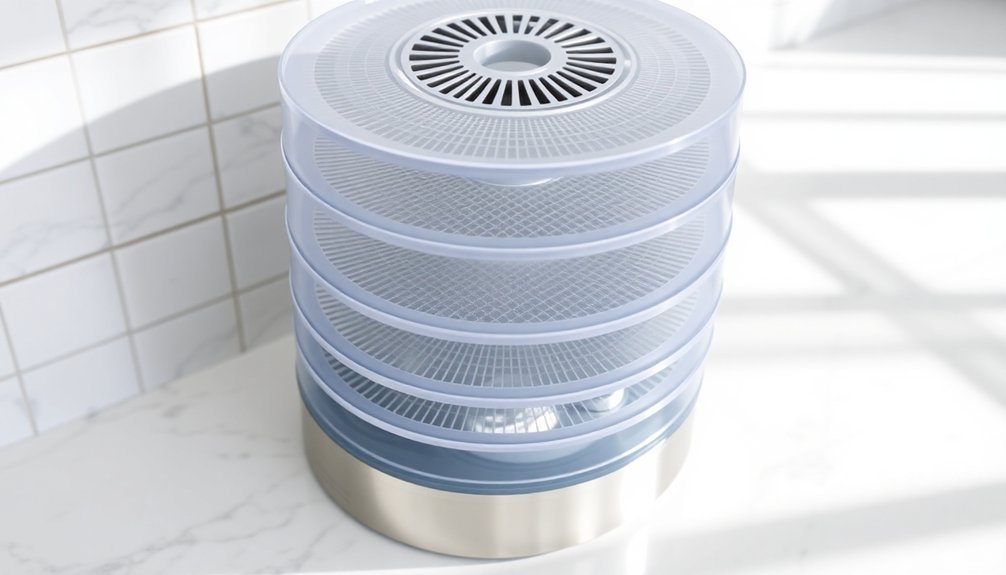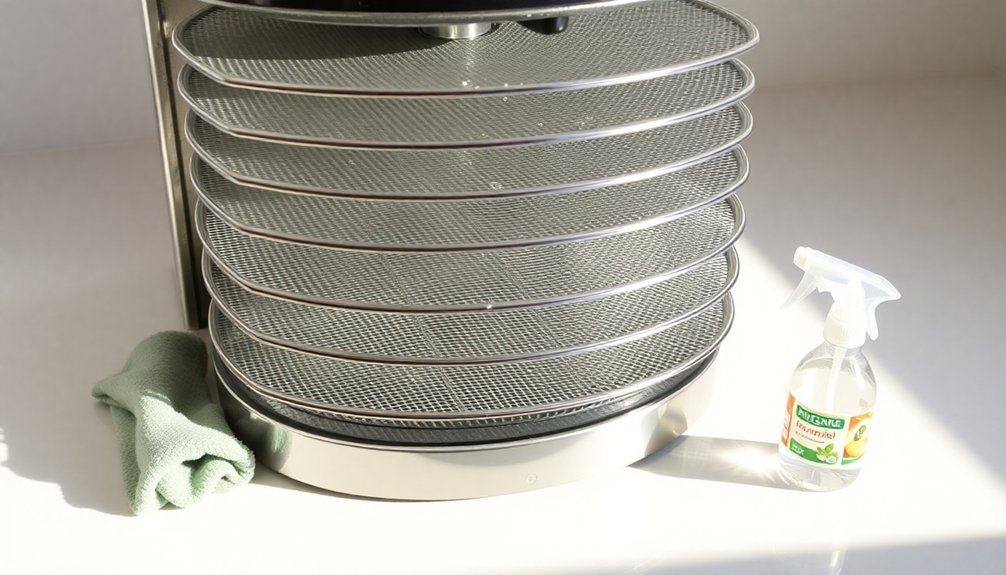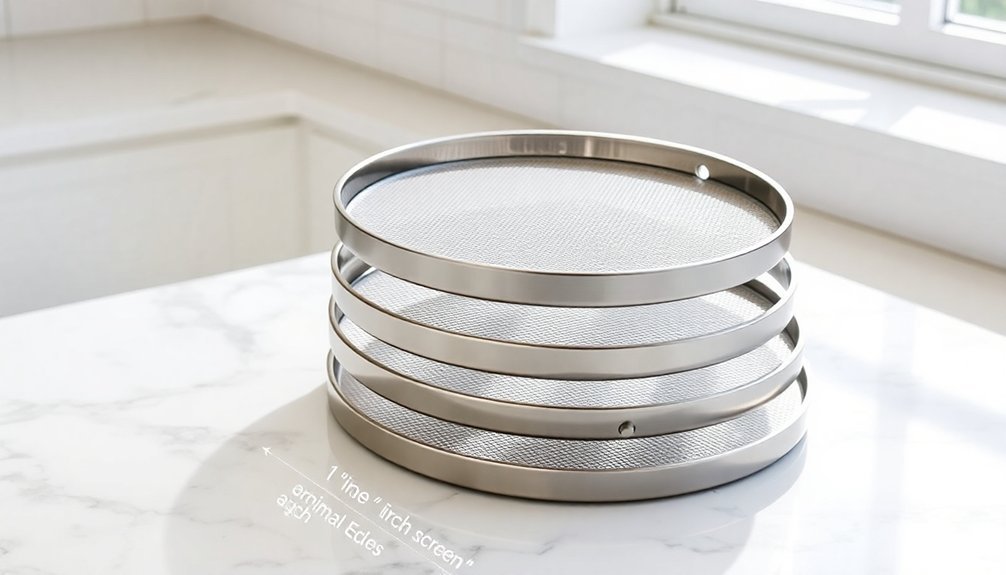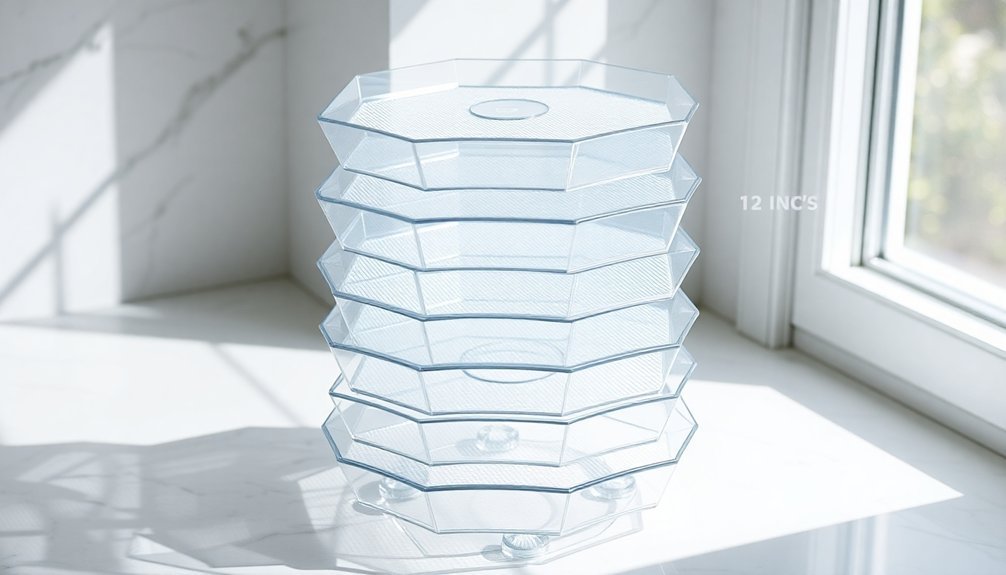Modern compact dehydrators with multi-layer stacking systems let you maximize your small kitchen's food preservation capabilities while minimizing counter space usage. You'll find vertical designs with slide-out trays that offer up to 30 sq ft of drying space, and square trays provide more usable area than round ones. Premium models feature dual-fan technology and digital controls for precise temperature management between 70-190°F, while stainless steel construction guarantees durability and even heat distribution. With proper placement and maintenance, these space-saving units can transform your food preservation routine while keeping your kitchen organized and efficient. The smart design features of today's compact dehydrators might surprise you.
Understanding Space-Efficient Dehydrator Design

Space-efficient dehydrators stand out from among traditional models by maximizing their drying capacity within a compact footprint.
You'll find that modern designs like the Cosori Premium Mini achieve this by incorporating vertical stacking with slide-out trays, making the most of your limited counter space while maintaining functionality. Models like Excalibur offer up to 600 watts of power for faster drying times.
When you're comparing dehydrator designs, you'll notice significant differences in tray configurations.
Square trays, like those in Excalibur and Cosori models, offer more usable space than round ones. For instance, Cosori's 13" x 12" trays provide 156 square inches of drying area, while Nesco's round Snackmaster trays only offer 118 square inches.
You don't lose valuable space to center holes with square designs.
The way you access your food matters in compact spaces.
Slide-out tray systems, featured in Cosori and Excalibur models, let you check and rotate foods without removing other trays. This design proves more practical than stacking models where you'll need to lift multiple trays to reach lower layers.
Digital controls and see-through doors further enhance the space-efficient design by allowing you to monitor your food without opening the unit.
Benefits of Stackable Tray Systems
Modern stackable tray systems raise the compact dehydrator design by offering remarkable versatility in batch sizes. You'll find models like the NESCO 1018P that can expand up to 30 trays, providing an impressive 30 square feet of drying space. When you're working with smaller batches, you can simply remove unnecessary trays to optimize the unit's efficiency. The fan and thermostat ensure precise temperature control for optimal drying results.
| Feature | Benefit | Impact |
|---|---|---|
| Expandable Capacity | Add up to 30 trays | Accommodate varying batch sizes |
| Efficient Airflow | Hybrid ducting system | Even drying across all trays |
| Space-Saving Design | Vertical stacking | Minimal countertop footprint |
The airflow system in these stackable units guarantees consistent drying results. You'll find fresh, warm air being distributed through a central core, then moving laterally across each tray. This design helps prevent moisture issues and uneven drying. When it comes to maintenance, you'll appreciate the dishwasher-safe trays and easy-to-clean base plates. The vertical configuration maximizes your kitchen space while providing the flexibility to adjust capacity based on your needs. With automatic shutdown features and efficient venting systems, you're getting both safety and performance in one compact package.
Small Kitchen Storage Solutions

While maximizing storage in a small kitchen presents challenges, innovative vertical and hidden storage solutions can transform your limited space into a highly functional cooking area.
You'll find that utilizing vertical space effectively through open shelving, hooks, and magnetic strips can greatly expand your storage capacity while keeping essentials within easy reach. Using tiered organizers helps optimize every inch of vertical cabinet space.
Don't overlook hidden spaces in your kitchen. Install under-sink storage bins, toe-kick drawers beneath cabinets, and under-cabinet baskets to maximize every inch of available space.
The backs of cabinet doors can become valuable real estate with mounted racks for spices or cleaning supplies.
Consider incorporating multi-functional furniture and organizers. A movable kitchen island with built-in shelving provides both workspace and storage, while pull-out drawers in deep cabinets guarantee you're using space efficiently.
Clear containers, matching food storage sets, and drawer organizers help maintain order and prevent clutter.
To enhance accessibility, install lazy Susans in corner cabinets and use shelf risers to double your vertical storage capacity.
These solutions not only maximize space but also make it easier to find and reach items when you need them.
Air Flow Technology
Your compact dehydrator's vertical flow design guarantees uniform drying by letting warm air rise naturally through multiple trays.
The dual-fan system optimizes heat distribution, preventing moisture buildup and hot spots that could affect your dried goods.
Advanced circulation technology maintains consistent airflow throughout the unit, helping you achieve reliable results even in limited kitchen spaces.
Vertical Flow Design Benefits
Today's vertical flow dehydrators leverage innovative airflow technology that revolutionizes the food preservation process. You'll find that these units feature strategically placed fans at either the top or bottom, pushing air through the trays in a way that's particularly gentle on delicate foods like herbs, strawberries, and peaches.
The vertical flow design's key advantage is its hybrid airflow system, which ducts warm air separately to each tray. This means you won't have to worry about flavors mixing between different foods, and you'll get consistently even drying results without rotating trays.
The air flows sideways and exits laterally across each tray, ensuring uniform dehydration throughout.
You'll appreciate how this design maximizes your counter space while delivering professional results. The compact structure doesn't compromise performance – instead, it enhances it.
When you're not using the dehydrator, you can compress it for easy storage, making it ideal if you're working with limited kitchen space. Plus, you won't need to clear extensive counter space or pull heavy appliances from cabinets to start your food preservation projects.
Dual-Fan Heat Distribution
Building upon the vertical flow design, modern dehydrators now incorporate sophisticated dual-fan technology that takes air circulation to the next level.
You'll find that these computer-controlled fans work either independently or simultaneously, allowing for precise airflow management throughout all trays while reducing both energy consumption and noise levels.
The system's intelligence shines through its ability to adjust fan operation based on your batch size. When you're dehydrating smaller amounts, you won't waste energy running both fans at full capacity.
The dual-fan setup works in perfect harmony with the Two-Stage Sequential Temperature-Timer (TST), which lets you start at higher temperatures (up to 155°F) before automatically switching to lower ones (118°F or less) to preserve nutrients and flavors.
You'll appreciate how the radial fans balance fresh and recirculated air, creating ideal drying conditions while maintaining energy efficiency.
The fully insulated design prevents heat loss, and the advanced airflow distribution ensures that flavors don't mix when you're drying different foods simultaneously.
This technology delivers 85.5% efficiency in commercial units, making your dehydrating process both effective and economical.
Enhanced Circulation Technology
Modern compact dehydrators revolutionize food preservation with their enhanced circulation technology, featuring advanced airflow systems that maximize both efficiency and consistency.
You'll find quiet radial fans that perfectly balance fresh and recirculated air, while washable filters prevent contaminants from affecting your food.
The multi-tier design works seamlessly with this technology, as high-heat circulation travels through each stackable tray level.
You won't need to rotate or constantly monitor your food, thanks to the double row vents that accelerate water vapor discharge.
The transparent door lets you check progress without disrupting the drying process.
Smart sensors and dual heaters automatically adjust power levels throughout the drying cycle, maintaining ideal temperature between 70° and 190°F.
You'll preserve more nutrients and flavor while using considerably less energy than conventional ovens.
The system's precision guarantees consistent results across all tray levels, whether you're working with delicate ingredients or larger batches.
This enhanced circulation technology doesn't just dry your food – it improves the entire preservation process, delivering superior texture, color, and uniformity while fitting perfectly in your compact kitchen space.
Material Quality and Durability

You'll find that stainless steel racks offer superior durability with their rust-resistant properties and ability to withstand high temperatures up to 150°C without warping.
The non-reactive nature of stainless steel guarantees your dried foods won't pick up any metallic taste while maintaining ideal food safety standards throughout the dehydration process.
ABS construction provides a lightweight yet sturdy alternative, featuring FDA-approved materials that resist heat damage and offer easy cleaning for long-term maintenance.
Stainless Steel Benefits
Stainless steel stands out as the premier material choice for compact dehydrator racks, thanks to its exceptional durability and superior material properties.
You'll appreciate its impressive thermal conductivity control, which guarantees even heat distribution throughout your dehydrating process. With its high tensile strength and resistance to warping, your racks won't bend or deteriorate under regular use.
The material's excellent corrosion resistance means you won't have to worry about rust forming on your racks, even in the humid conditions that food dehydration can create. The passive oxide layer, formed by the chromium content, provides natural protection that keeps your racks looking pristine and food-safe.
You'll find the surface easy to clean and maintain, as stainless steel resists both acidic and alkaline substances commonly found in foods.
For your compact kitchen setup, you'll benefit from stainless steel's impressive durability-to-weight ratio. At 7.8 grams per cubic centimeter, it's sturdy enough to handle heavy loads while remaining manageable.
The material's high fatigue strength guarantees your racks will maintain their structural integrity through countless dehydrating cycles, making them a reliable long-term investment for your kitchen.
ABS Construction Features
Many compact dehydrators feature ABS construction, offering an impressive balance of durability and lightweight design.
You'll find that ABS's thermoplastic polymer composition provides excellent impact resistance while keeping the unit easy to move and store. This material won't rust or corrode like metal alternatives, and it's particularly well-suited for maintaining its shape through repeated use in humid kitchen environments.
When it comes to maintenance, you'll appreciate how simple it's to keep your ABS dehydrator clean. A quick wipe-down with a damp cloth and mild detergent is typically all you'll need, though you should avoid abrasive cleaners that might damage the surface.
Key advantages of ABS construction include:
- Exceptional durability for daily kitchen use
- Lighter weight compared to stainless steel models
- Resistance to common cleaning agents and chemicals
- Cost-effective manufacturing, resulting in lower prices
- Non-porous surface that won't retain food odors or flavors
While ABS may not conduct heat as effectively as metal, it's more than adequate for standard dehydrating tasks.
You'll find that this material offers the perfect combination of practicality and performance for compact dehydrator designs.
Temperature Control Features
Precision meets convenience in the temperature control features of compact dehydrators. You'll find a digital LCD display screen that makes temperature adjustments straightforward, with settings reaching up to 180°F for ideal dehydration. The precise temperature control system helps retain up to 97% of your food's vitamins and minerals, ensuring nutritional value isn't compromised during the drying process.
You can customize your dehydration cycles using the programmable time and temperature settings. The Time and Temp Memory feature lets you quickly repeat successful drying cycles, while the Delay Start option builds proper humidity levels before initiating the exhaust cycle.
The system's precision thermostats operate within a 30-90°C range, delivering consistent heat circulation through each tray. The Program Control feature enables you to run multiple drying stages automatically within a single cycle.
You'll have access to pre-set programs through the Select Program Screen, making it easy to accommodate different food types. When the drying cycle completes, the automated cooling system brings your food and trays to a safe handling temperature, preventing overheating while maintaining ideal drying conditions throughout the process.
Cleaning and Maintenance Tips

Keeping your compact dehydrator in top condition starts with proper cleaning after each use. Begin by soaking your trays and liners in warm, soapy water for at least 20 minutes to loosen stuck-on food particles. For sticky residues from foods like honey or jerky marinades, you'll want to extend the soaking time, possibly overnight.
- Use soft bristle brushes instead of dish rags for more effective cleaning, especially on mesh screens.
- Avoid metal utensils or abrasive cleaners that could damage your trays.
- Consider using specialized cleaners like Dawn Platinum or PBW for stubborn residues.
- Vacuum crumbs before wiping to make cleanup easier.
- Roll mesh screens when rinsing to remove soap suds quickly.
After cleaning, you can dry your trays directly in the dehydrator on low heat for 20-30 minutes or air dry them completely before storage.
To prevent future cleaning challenges, use parchment paper or ParaFlexx sheets when dehydrating sticky foods. Don't forget to regularly clean the blower and air vents with a damp cloth to maintain peak performance.
Store your dehydrator in a dry place, covered to protect it from dust, and keep non-stick liners rolled in cardboard tubes for better organization.
Safety Considerations
Safe operation of your compact dehydrator requires attention to several critical factors. When setting up your unit, place it on a heat-resistant surface in the center of your counter, away from burners and edges. Don't operate it on glass surfaces, wood, or tablecloths that aren't heat-resistant.
You'll need to focus on electrical safety by using a polarized plug correctly and never defeating this feature. Don't use the dehydrator if the cord is damaged, and keep the cord, plug, and motor base away from water. Verify the power cord doesn't hang over counter edges or touch hot surfaces.
For food safety, you must maintain proper temperature and airflow throughout the drying process. Don't overload the trays, as this can prevent even drying and create food safety risks. Always preheat your dehydrator before adding food, and use accurate temperature measurement methods to verify proper pathogen reduction.
When cleaning your unit, avoid metal scrubbing pads that could cause electrical hazards. If children are present, provide constant supervision. Only use manufacturer-approved attachments, and stick to the dehydrator's intended purpose for safe, effective operation.
Food Preparation Space Management

Beyond safety protocols, smart space management can transform your compact kitchen into an efficient food preparation hub.
When working with dehydrator racks in a small space, you'll need to create designated zones that allow for seamless workflow while maintaining organization. Position your food prep station near the dehydrator to minimize movement and reduce the risk of accidents.
Consider these space-enhancement strategies for your dehydration workspace:
- Install wall-mounted shelving directly above your prep area to keep essential tools and ingredients within arm's reach.
- Use a movable cart with built-in storage to extend your workspace when needed and store it away when not in use.
- Implement a pull-out cutting board over your sink to maximize counter space during intensive prep sessions.
- Create a dedicated zone for cooling racks and finished products that doesn't interfere with ongoing preparation.
- Utilize vertical storage solutions for storing dehydrated foods and supplies without cluttering valuable counter space.
Remember to keep your most-used dehydrating tools and ingredients close to your primary work area.
Consider installing under-cabinet lighting to guarantee ideal visibility during food preparation, and maintain clutter-free countertops by using wall-mounted storage solutions whenever possible.
Maximum Capacity in Minimal Space
Modern compact dehydrators pack impressive capacity into space-saving designs. You'll find models like the NutriChef Kitchen Dehydrator offering five stackable trays within a modest 11-inch square footprint, while the Brod and Taylor Sahara takes space efficiency further with its innovative folding design that reduces to one-third of its size for storage.
Despite their compact dimensions, these units don't compromise on drying capacity. The Elite Gourmet EFD319's adjustable tray heights let you customize the space between layers to accommodate different food thicknesses, while its vertical airflow system guarantees consistent drying across all five trays.
The Brod and Taylor Sahara provides an impressive one square meter of drying area, demonstrating how vertical stacking maximizes capacity in limited counter space.
You'll appreciate practical features that enhance the space-to-capacity ratio, such as stackable tier trays that promote better airflow. The NutriChef's 11" x 11" x 1.2" trays offer ample room for various foods while maintaining a small footprint.
Whether you're drying fruits, vegetables, meats, or herbs, these space-conscious designs deliver professional-grade dehydrating capacity without overwhelming your kitchen space.
Energy Efficiency Ratings

Your compact dehydrator's energy efficiency depends largely on its wattage, which typically ranges from 200-300 watts for small, round models to 600 watts for mid-sized units.
You'll find most compact models draw considerably less power than their larger counterparts, with eco-mode features helping to reduce the maximum power draw even further.
When you're comparing models, look for units with automated shut-off timers and adjustable temperature controls, as these features can help optimize your dehydrator's energy consumption while maintaining effective drying performance.
Wattage Per Hour Usage
Understanding a compact dehydrator's energy consumption is essential for both your utility bills and kitchen efficiency. You'll find that most compact models operate between 200-300 watts per hour, making them more energy-efficient than their larger counterparts. When you're running a small dehydrator, you can expect to use around 0.35 kWh per hour, similar to the Elite Gourmet model's consumption rate.
- Compact 5-tray units typically consume 400 watts (0.4 kWh/hour)
- Smaller models use as little as 200-300 watts (0.2-0.3 kWh/hour)
- Energy-efficient horizontal airflow systems reduce operating time
- Thermostat controls help optimize power usage for different foods
- Clear windows prevent energy waste from door opening
Your compact dehydrator's wattage directly impacts your operating costs, but don't forget that efficiency isn't just about power consumption.
Models with precise temperature controls and multi-phase drying capabilities can actually save energy by optimizing the drying process. While compact models might run longer than larger units, their lower wattage means you're still consuming less power overall.
Look for units with automatic shut-off features to prevent unnecessary energy use once your food reaches the desired dryness level.
Maximum Power Draw Comparison
Selecting a dehydrator with the right power rating requires careful consideration of both capacity and energy efficiency. You'll find that most residential dehydrators operate between 400-660 watts, though some models like the Cosori and Nesco Gardenmaster Pro draw up to 1000 watts.
If you're working with limited kitchen space, compact models like the Elite Gourmet use just 350 watts, making them more energy-efficient for small batches.
For ideal power management, consider models with advanced features like the Tribest Sedona Combo's dual fan technology and independent fan control. These features let you adjust power usage based on your batch size.
The two-stage sequential temperature timer prevents unnecessary power draw by maintaining precise temperature control. While higher-capacity models typically consume more power, some manufacturers have implemented smart design elements to offset this.
The Excalibur 3926T, for instance, manages to run efficiently at 600 watts despite its larger size.
When comparing power ratings, remember that wattage isn't the only indicator of efficiency. Features like optimized airflow systems and vertical vents can help maintain consistent drying while minimizing energy waste.
Eco-Mode Operating Features
Modern dehydrators now come equipped with eco-mode features that considerably reduce energy consumption while maintaining ideal drying performance. You'll find that these energy-efficient models typically consume around 1 kW/hr, making them more economical than traditional preservation methods like canning or freezing.
With precise digital controls offering 1°F increments and 30-minute timer intervals, you can fine-tune your settings for maximum energy use.
Key eco-mode features you'll benefit from include:
- Automatic shut-off systems that prevent unnecessary power usage once your food is properly dried
- Smart temperature control with thermostat regulation that adjusts power based on dehydrating needs
- Energy-saving presets designed specifically for different food types
- Efficient air circulation systems that reduce overall drying time
- High-quality insulation materials that minimize heat loss and power consumption
You can further maximize efficiency by using the custom presets for specific foods and taking advantage of batch processing capabilities.
The compact design of these units, often featuring stainless steel and engineered ABS materials, guarantees better heat retention in small spaces.
When properly maintained, you'll find that these eco-mode features help maintain energy efficiency throughout the dehydrator's lifetime.
Frequently Asked Questions
How Long Does Beef Jerky Typically Take to Dehydrate Completely?
You'll need 3-10 hours to dehydrate beef jerky completely, depending on your slice thickness. Thin cuts (1/8-1/4 inch) take 3-5 hours, while thicker slices (1/2 inch) require 7-10 hours at 160-165°F.
Can I Dehydrate Different Types of Food Simultaneously on Different Trays?
You can dry different foods simultaneously, but you'll need to guarantee they require similar temperature settings and drying times. For best results, group foods with compatible dehydrating requirements on separate trays.
Will Dehydrating Foods Create Strong Odors in My Small Kitchen?
Yes, you'll experience strong odors when dehydrating certain foods like onions, garlic, and greens. However, you can minimize smells by using proper ventilation, freezing ingredients first, or dehydrating in a separate space.
Does the Dehydrator Produce Much Noise While Operating?
You'll notice dehydrators vary in noise levels from whisper-quiet (37 dB) to moderately loud (66+ dB). Most home models run around 50-59 dB, similar to a quiet office. You can reduce noise by placing it strategically.
Can I Leave the Dehydrator Running Overnight Unattended?
You shouldn't leave your dehydrator running overnight unattended unless it has automatic safety features. It's safer to monitor the process or use a timer, as extended unsupervised operation can pose safety risks.
In Summary
You'll find that compact multi-layer dehydrators are ideal for your small kitchen needs. By choosing a stackable system with efficient airflow and durable materials, you're maximizing your food preservation capabilities while minimizing space usage. You can easily store these units when not in use, and they'll help you maintain an organized kitchen workflow. Their energy-efficient design saves you money while delivering professional-quality results.





Leave a Reply